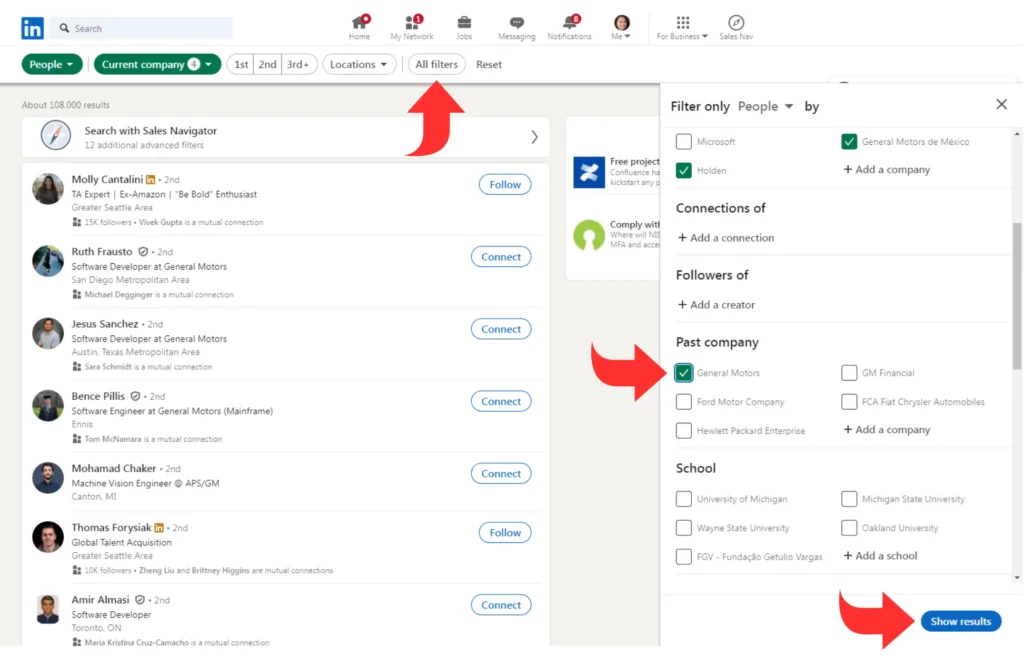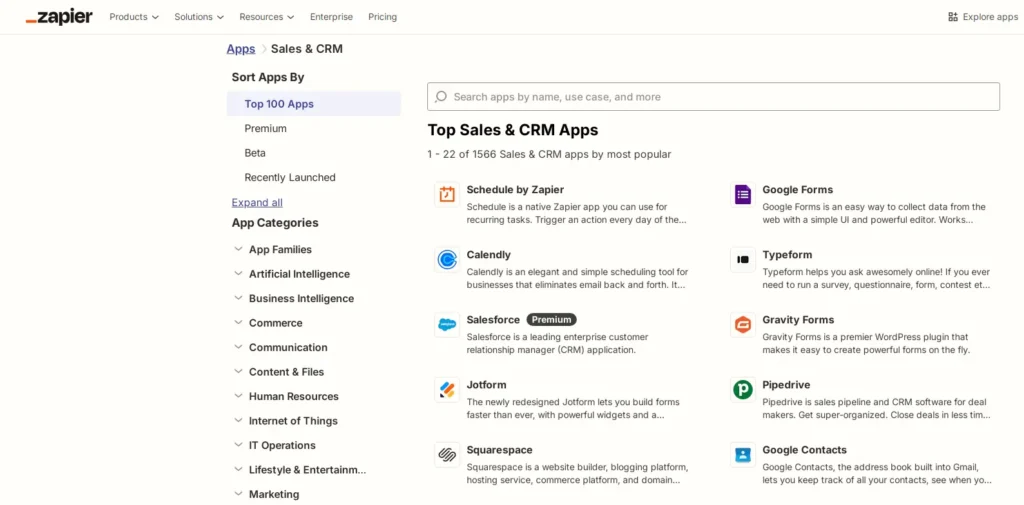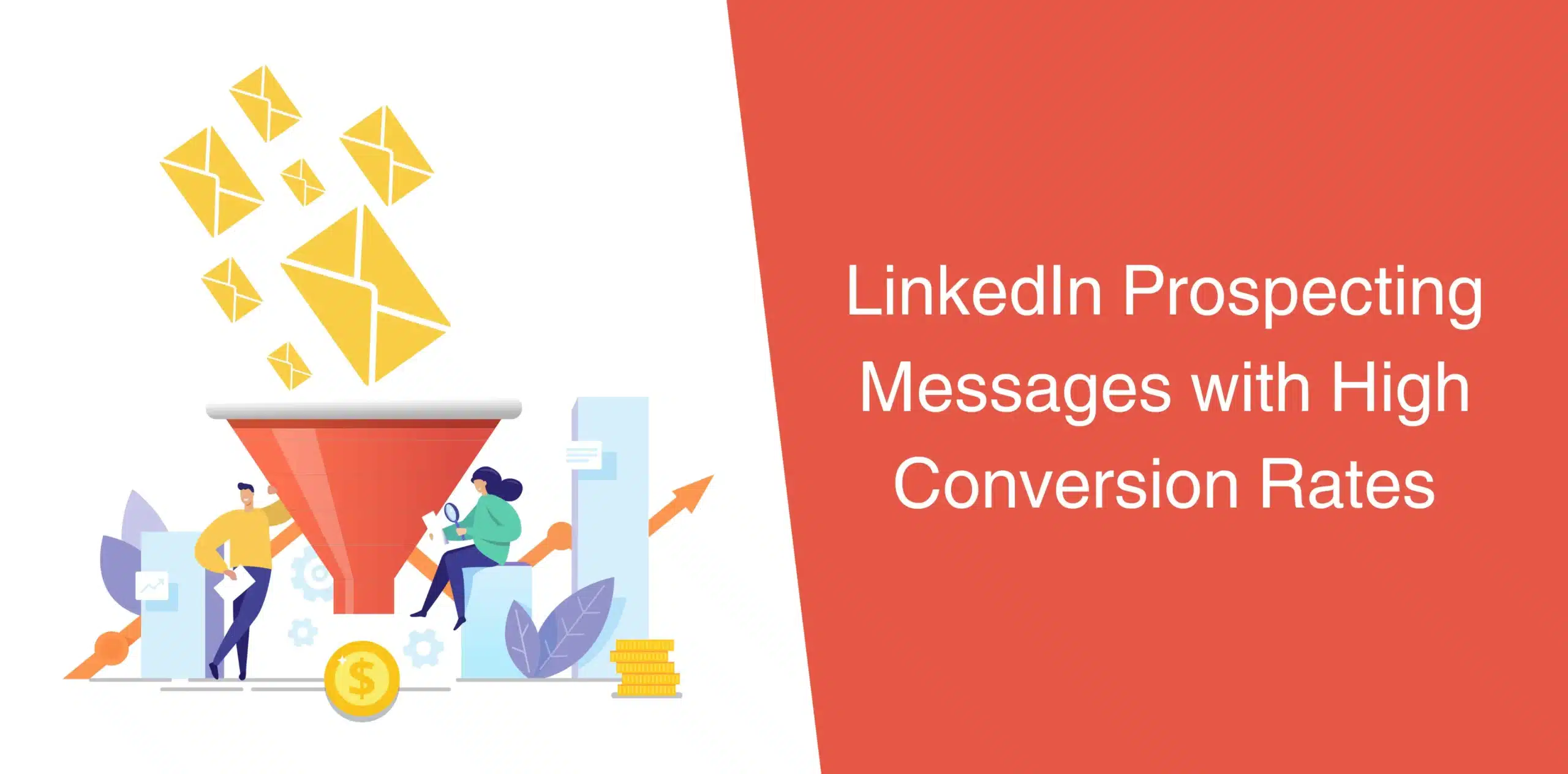The success of sales prospecting on LinkedIn depends on how well your messages resonate with the recipients. The words you choose can turn a cold contact into a warm lead, helping you book a decent number of appointments.
But in a world where decision-makers are bombarded with countless messages daily, how do you make your LinkedIn prospecting messages stand out?

In this comprehensive guide, we’ll break down the key components of writing compelling LinkedIn sales prospecting messages, share actionable tips, provide examples and templates, and even show you how to streamline the process using LinkedIn automation tools like Octopus CRM.
What Is a LinkedIn Prospect Message?
A LinkedIn prospect message is a targeted communication sent to potential clients or business partners via LinkedIn. It is a core component of any B2B prospecting plan that involves the use of LinkedIn.
The goal is to connect, nurture a relationship, or directly pitch a product or service.
Unlike a cold email, which can often feel impersonal or intrusive, a LinkedIn message is more personalized and relevant to the recipient’s professional interests and needs.
The effectiveness of your LinkedIn sales prospecting messages depends on multiple factors, such as clarity, relevance, and timing. Keep in mind that it’s not only about the message itself but how you deliver it and the delivery timing.
The best LinkedIn prospecting messages strike a balance between being informative and engaging without being overly pushy or salesy.
Plus, personalization can help you receive positive responses and boost your sales. As such, it is a good idea to tailor your messages to reflect the recipient’s recent achievements, industry challenges, or specific business needs. Personalization positions you as a thoughtful and credible partner, rather than just another salesperson.

How to Write LinkedIn Prospecting Messages
Here are seven essential steps to guide you in writing LinkedIn messages that convert:
1. Research Your Prospect
Before you start writing a message, it is always best to research your prospect thoroughly. Understand their role, company, industry, and recent activities on LinkedIn. Here are the basics of LinkedIn prospecting to learn how to find and connect with future clients.
What challenges might they be facing? What are their goals?
This information will help you tailor your message to their specific needs and increase the chances of a positive response.
But where do you find all this information?
Start by reviewing their LinkedIn profile to gather information on their current role, company, industry, and professional achievements. Pay attention to their recent activity, such as posts, comments, and articles, which can give you insights into their interests and challenges.
Also, explore the company’s LinkedIn page to understand its culture, recent updates, and key projects.
Beyond LinkedIn, you can use Google to find press releases, news articles, and blogs related to the prospect or their company. It is also good to check the company’s website, especially the “About Us” and “News” sections because it can provide valuable context.
Tools like Crunchbase can also offer insights into the company’s financials, investments, and growth trajectory, helping you tailor your message more effectively.
When you do your homework, your message will stand out because it shows you took the time to understand them. This personalized approach is far more effective than generic messages that could apply to anyone.
2. Write a Compelling Subject Line
Your subject line is your first opportunity to capture your prospect’s attention and pique their interest.
A good subject line is concise, relevant, and attention-grabbing, giving the recipient a reason to open your message. Avoid clichés and be direct about the value you’re offering.
Avoid generic phrases or clickbait tactics, as these can come across as insincere or even deceptive. Instead, focus on creating a subject line that piques curiosity, offers a clear benefit, or references a mutual connection or shared interest.
For example, instead of saying, “Interested in a quick chat?” try something like, “Helping [Prospect’s Company] Enhance [Specific Outcome].” This immediately tells them what’s in it for them and sparks curiosity.
“Ideas to Boost Your Sales in Q4” or “Connecting on [Shared Interest]” are also good examples of subject lines that intrigue the recipient, encouraging them to open your message.
3. Personalize Your Message
Personalizing your message goes beyond simply inserting the recipient’s name or company into a template. Instead, it should demonstrate that you’ve done your homework and understand their specific needs, challenges, or goals.
This is where you can leverage the information you gathered during your research from step 1.
Did you find something specific about their business? A recent product launch? A blog post they published? Or maybe you found a challenge they’re facing.
In your message, you can mention the information from your research to stand out in the recipient’s cluttered inbox. This approach indicates that you’re genuinely interested in their success, not just in making a sale.
For instance, if they’ve recently posted about a new initiative, you might mention how your solution aligns with or supports that initiative.
Moreover, personalization means matching the tone and language to the recipient’s communication style. If they use a more formal tone in their posts or profile, reflect that in your message.
Conversely, if they have a casual, approachable style, you can mirror that to create a connection. This subtle adjustment makes your message feel more like a natural conversation rather than a one-size-fits-all pitch.
4. Establish Relevance Early
So, once you start writing your message, make sure to mention your intention to reach out within the first few sentences. Whether you’re offering a solution to a problem they might be facing or sharing insights that could be beneficial, communicate it early on.
For example, if you’re reaching out to a marketing manager, you might say, “I noticed that your team is focusing on expanding digital outreach — our platform has helped companies like yours boost engagement by 30%.”
5. Offer Value Before Asking for Anything
Before making any requests, such as scheduling a call or meeting, provide value to the recipient. This could be in the form of a helpful resource, a valuable insight, or a tailored suggestion.
When you give something of value first, it can help you create goodwill and make the recipient more likely to respond positively.
For instance, you could share a relevant case study, a whitepaper, or even a brief audit of their current strategy (if applicable). The idea is to position yourself as a helpful advisor rather than just another salesperson.
6. Include a Catchy CTA

While the starting and body of your message are vital, how you end your message is equally important.
Your LinkedIn prospect message should end with a clear and concise call to action.
What do you want your prospect to do next?
Whether it’s scheduling a call, booking an appointment, replying with feedback, or downloading a resource, make sure your CTA is specific and easy to follow.
After all, the purpose of your LinkedIn sales prospecting messages is to encourage some form of action.
While your CTA should be direct, it shouldn’t be pushy.
For example, instead of just saying, “Let’s connect,” you could say, “Would you be open to a 15-minute call next week to explore how we can help boost your sales?”
This approach is polite yet assertive, providing clear direction while respecting the prospect’s time.
Plus, always try to make your CTA more flexible, such as suggesting two possible times for a meeting or offering to send over more information via email. This not only makes it easier for the recipient to respond but also shows that you’re considerate of their schedule.
A well-crafted CTA can significantly increase the likelihood of moving the conversation forward, ultimately helping you achieve your sales prospecting goals.
7. Follow Up Strategically
Not all prospects will respond to your first message, and that’s okay.
A well-timed follow-up can make a huge difference. When following up, be polite and respectful, and provide an additional reason for them to engage.
You might say something like, “Just following up on my previous message — I wanted to share this recent case study that might be of interest to you. Let me know if you’d like to discuss how we could achieve similar results for [Prospect’s Company].”
Tips for a Good LinkedIn Prospecting Message
Now that you’ve learned the steps to writing a compelling LinkedIn prospecting message, check the LinkedIn prospecting techniques to increase your chances to win clients.
Let’s explore more tips to write even better messages.
1. Keep it Short and Sweet
LinkedIn data shows that shorter messages usually get more replies than longer ones.
When your message is under 300 characters, it tends to perform better. You’re not asking your prospect to put in a lot of effort reading your message.
No one likes reading long messages from someone they don’t know. It’s just too much to ask when you’re reaching out for the first time.
Aim for brevity while still providing value. Your message should be concise, easy to read, and to the point. Ideally, it should be readable within 30 seconds.
But keeping your message short doesn’t mean sacrificing substance for brevity. Instead, focus on delivering your core message in a way that is both efficient and impactful.
Identify the key points you want to convey. Then trim any unnecessary details or filler language. Each sentence should serve a purpose, guiding the recipient toward the action you want them to take.
It is also good to use bullet points or short sentences where appropriate. This will help make your message more scannable and digestible.
A message that is clear and to the point not only respects the recipient’s time but also increases the likelihood that they’ll actually read and respond to your outreach.
2. Use a Friendly and Professional Tone
You want to come across as approachable and helpful, not overly formal or pushy.
A friendly tone helps you come across as personable and relatable, which is crucial for building rapport with your prospects. However, it’s equally important to maintain a level of professionalism that reflects your expertise and the seriousness of the business discussion.
This combination ensures that your message is welcoming and warm, without compromising on authority or respect.
Avoid overly formal language that might seem stiff or distant, as well as slang or overly casual expressions that could undermine your professionalism. Instead, stick to a conversational style that feels natural and engaging, yet polished.
Phrases like “I noticed your recent post about…” or “I’d love to explore how we can work together…” can help convey warmth and genuine interest while still keeping the conversation business-focused.
3. Qualify Your Lead with a Question
The main goal of most LinkedIn messages isn’t to secure a meeting — it’s to qualify your lead.
You wouldn’t want to waste time meeting with someone who isn’t a good fit, right?
To do this, ask a question that will quickly reveal whether continuing the conversation is worthwhile.
Think of your LinkedIn outreach as a two-step process:
- Ask if the prospect is facing the specific problem your solution addresses;
- If they are, then move forward and suggest a meeting;
- If they aren’t, it’s probably not worth pursuing further.
Remember, prospecting is about qualifying, not selling. Once you confirm that your prospect has a problem you can solve, the selling part becomes much easier.
4. Support Your Question with Data
It’s important to help your prospect understand the reason behind your question as it can help you establish credibility and trust.
People are unlikely to take a stranger’s word at face value. You need to provide data, examples, or concrete evidence to back up your claims.
For instance, if you mention that you’ve helped a business similar to theirs, it’s more effective to name the company and describe the results you achieved. Avoid making claims you can’t substantiate — if you say you can deliver something, be ready to show proof.
5. Be Authentic

Authenticity goes a long way in making your LinkedIn prospecting message achieve its goals.
As such, you should avoid sounding like a corporate robot. Instead, let your personality shine through in your communication. People are more likely to engage with someone who feels real and genuine.
Sharing a bit about yourself, like your experiences or what drew you to connect, can create a more relatable and trustworthy interaction.
Also, share real insights or experiences that relate to the prospect’s situation, and be honest about what you can and cannot do. This level of transparency not only makes you more relatable but also sets realistic expectations from the outset.
Furthermore, avoid exaggerations or making promises you can’t keep, as these can quickly erode trust if they fall short. Prospects can usually sense when a message is scripted or insincere, so it’s important to communicate in a way that feels genuine and unforced.
4. Highlight Mutual Connections or Interests
If you share mutual connections or common interests with the prospect, it is a good idea to mention them in your message. This can help build immediate rapport and make your outreach feel less like a cold approach. It also provides social proof, which can increase trust.
Here’s an example:
Hi John,
I noticed that we both know Emily Thompson — she speaks highly of your work at EcoTech Solutions. Like you, I’m passionate about sustainable practices in business, and I’ve been working on some initiatives at GreenWave that might align with what you’re doing.
5. Focus on the Prospect’s Needs
Always keep your message focused on your prospect’s needs and challenges, not your product or service. Show them that you understand their pain points and have a real solution for them. The more you focus on them, the more likely they are to engage.
When you focus on what they stand to gain — whether it’s saving time, reducing costs, or achieving a particular goal — you make it easier for them to see the value in engaging with you.
Remember, when your message speaks directly to the prospect’s needs, they’re more likely to view you as a valuable partner rather than just another vendor.
6. Avoid Jargon and Buzzwords
While it’s important to sound professional, avoid overloading your message with jargon or industry buzzwords. These can often be confusing or off-putting, especially if they’re not familiar to the recipient.
Overcomplicating your language can detract from the core message and make it harder for prospects to understand the value you’re offering.
Instead, use clear and straightforward language that anyone can understand, focusing on simplicity and clarity. This not only ensures that your message is accessible but also demonstrates your ability to communicate effectively and empathetically.
7. Test Different Approaches

Don’t be afraid to experiment with different types of LinkedIn prospecting messages.
You can A/B test various subject lines, message lengths, tones, and CTAs. Over time, you’ll gather valuable data on what resonates most with your prospects.
For instance, you might try A/B testing different subject lines to gauge which ones achieve higher open rates, or test variations in the body of your message to see which approach gets more positive responses.
In addition to testing different content strategies, you could play around with the timing and frequency of your outreach. Some prospects may respond better to messages sent early in the morning, while others might prefer late afternoon.
The results of these tests will provide you with valuable insights into your audience’s preferences and behaviors. Regularly reviewing and adjusting your approach based on this feedback ensures that your prospecting efforts remain effective and continuously improve over time.
This iterative process also helps you adapt to changing trends and optimize your messaging for better engagement and conversion rates.
8. Respect the Prospect’s Time
Last but not least, always be mindful of the recipient’s time.
Instead of immediately pushing for a meeting or call, consider offering something of value that doesn’t require a time commitment, such as a free resource or insight.
Doing so indicates that you respect your prospect’s time and that you’re focused on providing value first.
LinkedIn Prospecting Messages Examples
Here are seven LinkedIn prospecting message examples to inspire your outreach:
The Value-First Approach
Subject: Helping Apex Innovations Enhance Your Lead Generation
Hi Jessica,
I noticed your recent post about improving lead generation strategies and thought it was insightful. I work with companies like Apex Innovations to achieve higher lead conversion rates, and I wanted to share a resource that might be helpful for you: [Link to Resource].
Let me know if you’d be interested in a brief chat to explore how we could help you boost your lead conversion metrics.
Best regards,
Alex Thompson
The Mutual Connection Approach
Subject: Connected Through Linda Carter
Hi Michael,
I see that we both know Linda Carter. I’ve heard great things about your work at InnovateTech, especially in developing cutting-edge software solutions.
I specialize in helping teams like yours overcome scalability challenges. I’d love to connect and share some ideas on how we could collaborate.
Looking forward to hearing from you,
Sarah Lee
The Industry Expert Approach
Subject: Emerging Trends in FinTech for SecurePay Solutions
Hi Emma,
As someone deeply involved in the FinTech industry, I wanted to reach out and share some insights that could benefit SecurePay Solutions. We’ve recently helped companies like yours achieve significant growth in transaction security, and I believe we could do the same for you.
Check out how we helped SecurePay Solutions: [Linked to success story].
If you’re open to it, I’d love to discuss it further.
Best,
David Kim
The Problem-Solution Approach
Subject: Addressing Your Customer Retention Challenges
Hi Ryan,
I’ve been following Elevate Marketing and noticed that your team is dealing with customer retention issues. We’ve helped other companies in your industry tackle this problem by implementing personalized engagement strategies.
Would you be open to a quick chat to see if we could help you as well?
Best regards,
Laura Green
The Complimentary Audit Approach
Subject: Free Website Audit for GreenTech Industries
Hi Natalie,
I’ve been reviewing GreenTech Industries’ online presence, and I noticed some areas where you could potentially improve your site’s performance and user engagement.
I’d love to offer you a complimentary website audit to identify opportunities for growth. Let me know if you’re interested.
Best,
Mark Rodriguez
The Case Study Approach
Subject: How We Helped Zenith Corp Achieve 30% Sales Growth
Hi Olivia,
We recently worked with Zenith Corp to achieve a 30% increase in sales through targeted marketing campaigns, and I believe YourTech Solutions could benefit from a similar approach.
If you’re open to it, I’d love to share the case study with you and discuss how we could replicate these results for your team.
Best regards,
Emily Carter
The Event Invitation Approach
Subject: Exclusive Invitation to the Future of Tech Summit
Hi James,
I’m reaching out to personally invite you to our upcoming Future of Tech Summit on September 15th. It’s a great opportunity to learn about the latest advancements in technology and connect with other professionals in your field.
I’d love to see you there and discuss how we can help TechPro Solutions achieve your innovation goals.
Best,
Michael Anderson
LinkedIn Prospecting Messages Templates
Here are seven LinkedIn prospecting message templates that you can customize for your outreach:
Personalized and Value-Driven
Subject: [Relevant Topic or Company] – How [Your Solution] Can [Benefit Them]
Hi [Prospect’s Name],
I noticed that [Company] is [Doing something relevant]. I’ve been following your work for a while, and I’m impressed by your [Specific achievement or accomplishment].
I believe our [Your company’s product or service] can significantly [Benefit the prospect]. It has helped [Client testimonial] achieve [Positive result].
Would you be open to a quick chat to explore how we can collaborate?
Best,
[Your Name]
[Your Position]
[Your Company]
Direct and Action-Oriented
Subject: [Relevant Topic] – Let’s Discuss [Your Solution]
Hi [Prospect’s Name],
I’m reaching out because I believe [Your company’s product or service] can address [Specific pain point or challenge] that [Prospect’s company] is facing.
I’d love to schedule a brief call to discuss how we can help you [Achieve a specific goal].
Looking forward to connecting.
Best,
Your Name]
[Your Position]
[Your Company]
Question-Based and Engaging
Subject: [Relevant Question] – Thoughts on [Industry Trend]?
Hi [Prospect’s Name],
I’ve been following the discussion around [Industry trend or topic]. I was curious to get your perspective on [Specific question].
As [Your company’s expertise], we’ve seen [Positive result] for companies facing similar challenges.
Are you interested in learning more about how we can help?
Best,
[Your Name]
[Your Position]
[Your Company]
Mutual Connection Introduction
Subject: Introduction via [Mutual Connection]
Hi [Prospect’s Name],
[Mutual Connection] suggested that we connect as we both share a passion for [Specific Topic]. I specialize in [Your Area of Expertise] and thought it would be valuable to exchange ideas.
Let’s connect and explore potential collaboration opportunities.
Best,
[Your Name]
Industry Insight Offer
Subject: Insights on [Industry Trend]
Hi [Prospect’s Name],
Given your role at [Prospect’s Company], I thought you might find our latest insights on [Industry Trend] valuable. We’ve been helping companies navigate [Specific Challenge] with [Solution or Strategy].
If you’re interested, I’d love to share these insights and discuss how they might apply to your team.
Best regards,
[Your Name]
Case Study Share
Subject: How [Similar Company] Achieved [Specific Outcome]
Hi [Prospect’s Name],
We recently helped [Similar Company] achieve [Specific Outcome], and I believe [Prospect’s Company] could benefit from a similar strategy. I’d love to share the case study with you and discuss how we can replicate these results for your team.
Looking forward to hearing from you.
Best regards,
[Your Name]
Offering a Complimentary Consultation
Subject: Complimentary Consultation: [Your Expertise]
Hi [Prospect’s Name],
As a [Your title or expertise], I’m offering complimentary consultations to help businesses like yours [Solve a specific problem or achieve a goal].
I’d love to discuss your current challenges and explore potential solutions. I would be grateful if you could spare 30 minutes for a meeting.
Best,
[Your Name]
[Your Position]
[Your Company]
Focusing on Industry Trends
Subject: [Industry Trend] – How [Your Company] Can Help
Hi [Prospect’s Name],
I’m reaching out because I believe [Your company] can provide valuable insights on the recent [Industry trend or development].
Our expertise in [Relevant area] has helped many businesses [Achieve a positive result].
Would you be interested in learning more about how we can help your company navigate this trend?
Best,
[Your Name]
[Your Position]
[Your Company]
How to Send LinkedIn Prospecting Messages with Octopus CRM
Octopus CRM is a powerful LinkedIn automation tool that can help you streamline the process of sending LinkedIn prospecting messages.
Here’s how you can use this tool to send prospecting messages:
1. Create a Targeted Prospecting List

Octopus CRM allows you to create a targeted sales prospecting list based on specific criteria such as industry, job title, location, and more. This ensures that your messages are reaching the right audience.
2. Personalize Your Outreach

Octopus CRM LinkedIn automation tool comes with built-in templates to personalize your message with the recipient’s name, company, and other relevant details. This level of customization is crucial for making your outreach more effective.
3. Automate Follow-Ups
One of the biggest advantages of using Octopus CRM is the ability to automate follow-up messages. You can schedule follow-ups to be sent at specific intervals, ensuring that no lead slips through the cracks.
4. Track Engagement
Octopus CRM provides detailed analytics on your outreach efforts, allowing you to track open rates, response rates, and other key metrics. This data can help you refine your approach and improve the effectiveness of your LinkedIn sales prospecting messages.
5. Integrate with Your CRM

Octopus CRM integrates seamlessly with popular CRM platforms, allowing you to sync your LinkedIn outreach efforts with your broader sales strategy. This ensures that all your prospecting data is centralized and easily accessible.
6. Compliance and Security
Finally, Octopus CRM is developed with compliance and security in mind. You can rest assured this tool adheres to LinkedIn’s terms of service and industry regulations.
Conclusion
When it comes to writing LinkedIn prospecting messages with high conversion rates, you need a combination of research, personalization, value-driven communication, and strategic follow-up.
With the right approach, your LinkedIn sales prospecting messages can help you build relationships and drive results.
Use the steps, tips, templates, and examples provided above to write compelling LinkedIn messages to a prospect that convert. Don’t hesitate to tailor the examples and templates to fit your unique voice and the specific needs of your prospects.
And with Octopus CRM LinkedIn automation tools, you can streamline the process and ensure that your outreach efforts are both efficient and effective.
Now that you have a good understanding of how to create and send LinkedIn prospecting messages with high open rates, it’s time to put these insights into action and start seeing real results.
